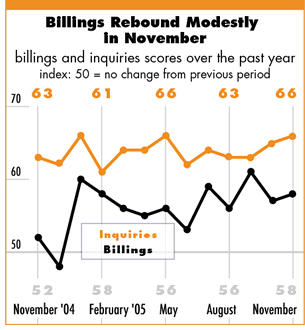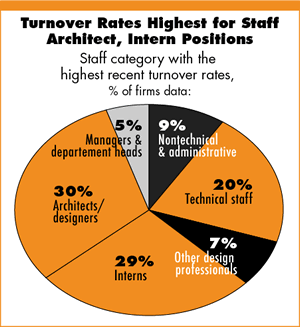

12/2005
Improving market conditions produce increased turnover rates

by
Kermit Baker, PhD, Hon. AIA
Chief Economist
 The AIA’s Architecture Billings Index bounced
back in November, signifying that U.S. architecture firms are seeing
increased levels of business. If firms report even modest gains in December,
2005 will be the first year since 2000 that firms reported gains every
month of the year. Given that billings at architecture firms lead construction
activity by approximately six months, these trends point to 2006 being
the best year for nonresidential construction since 2000.
The AIA’s Architecture Billings Index bounced
back in November, signifying that U.S. architecture firms are seeing
increased levels of business. If firms report even modest gains in December,
2005 will be the first year since 2000 that firms reported gains every
month of the year. Given that billings at architecture firms lead construction
activity by approximately six months, these trends point to 2006 being
the best year for nonresidential construction since 2000.
Inquiries for new work at firms in November also increased to the highest growth rate of the year. Given higher levels of inquiries, design projects should also be increasing over the next few months. Firms concentrating in the residential sector are reporting increased billings after slower levels of activity earlier this year. Commercial/industrial firms, as well as institutional firms, are both reporting strong growth in billings in recent months, so both of these major nonresidential sectors can expect improved conditions moving into 2006.
Regionally, firms in the Northeast and Midwest have seen substantial improvement in business conditions in recent months. Firms in the South and West have seen stable levels of growth in recent months. However, firms in all regions of the country are reporting healthy business conditions.
Overall economy looking up
The broader economy seems to have shaken off most of the negative effects
of the hurricanes from this past summer. After very modest gains in
September and October, payroll growth nationally increased by 215,000
positions in November, above the average of the first eight months
of the year. This puts the economy back on track to create 2 million
net new jobs this year.

Holiday season retail sales are another critical indicator of the economy’s health. Gains have been modest, with October retail sales growing at a 4 percent annual rate and November sales increasing only 3.1 percent when annualized. Retail sales in November increased 6.4 percent as compared to November 2004, whereas sales had been increasing in the 8-9 percent range compared to year-ago levels in the second and third quarters this year.
Still, there is some hope that the economy will end the year on an upnote. Leading economic indicators increased in October and November. The preliminary reading for consumer sentiment from the University of Michigan’s survey showed a large jump in December, coming on the heels of a large jump in November. Many analysts feel that falling retail gasoline prices are a key reason for this rebound in consumer optimism.
 Opportunities invite
turnover
Opportunities invite
turnover
As business conditions improve, many architecture firms note an increase
in staff turnover rates, since the opportunities at competing firms
increase. Almost 30 percent of architecture firms report turnover rates
greater than 10 percent over the past year. While 55 percent of firms
feel that turnover rates this year are comparable to previous years,
29 percent feel that they are higher, and only 13 percent indicate
that they are lower now.
Larger firms report somewhat higher levels of turnover rates this year, as do commercial/industrial firms. Over 40 percent of firms concentrating in commercial and industrial projects are reporting higher turnover rates this year compared to previous years.
Architecture positions requiring less experience are reported as having higher turnover rates. Thirty percent of firms report that nonmanagerial architect/designer positions have had the highest turnover recently, while almost as many (29 percent) report the highest turnover rates in intern positions. The other staff category where a significant number of firms report high rates of turnover is technical staff positions (e.g., drafters and IT managers).
Copyright 2005 The American Institute of Architects.
All rights reserved. Home Page ![]()
![]()
 |
||
This month, Work-on-the-Boards survey participants are saying: • Business is strong. This has been a record year for billings
and profit. We expect more growth next year. • Construction remains at a very high level, driving up
prices and creating shortages of labor and some materials. • Too few to choose from in the available pool of architects. • Business is slow and construction is down.
|
||